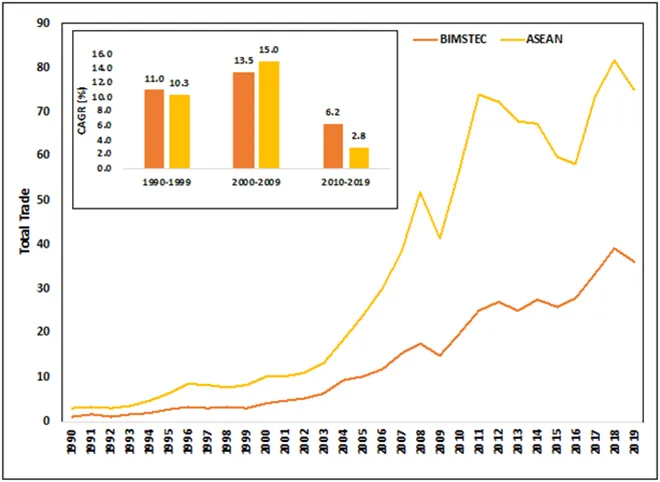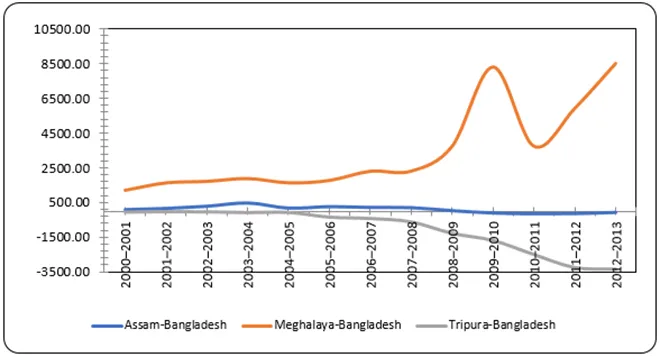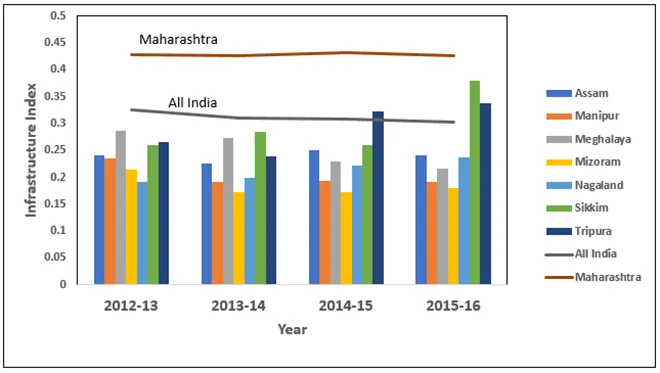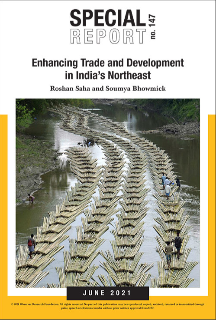Introduction
India’s North East Region (NER) has a geo-strategic location—sharing borders with countries such as Bangladesh, Bhutan, China, Myanmar and Nepal—that makes it conducive to international trade. The region is also rich in natural resources and biodiversity. However, the NER continues to face challenges that impede its development: among them armed insurgency, cross-border migration, movements that demand for separate federal states and autonomous units, and ethnic conflicts.[1] Several initiatives have been introduced by the central government, in an attempt to re-align the NER with the mainstream political and economic goals of the country. Most notable of these is the Act East Policy (AEP). It is therefore important to understand how such policies and initiatives have facilitated the economic development of NER.
The Northeastern states are economically important primarily on two fronts[2]– first, the strategic location of the region that connects India to the robust Southeast Asian markets[a] and second, the presence of potent input market catalysts such as social capital (diversity, cultural richness), physical (potential energy supply hubs), human (inexpensive, skilled labour) and natural (minerals, forests).
As one increasingly acknowledges the importance of economic connectivity for the overall development of the subregion, it is essential to understand the dynamics of trade and development of the NER by looking at the following questions:
- To what extent will the development of trade in the Northeast be compatible with the security imperatives of the region?
- Will the producers and service providers in the Northeast benefit from a proposed BIMSTEC Free Trade Agreement (FTA) and/or a hypothetical Bangladesh-Bhutan-India-Nepal (BBIN) FTA as a potential part of the regional commodity or service-value chains?
- How can technological enhancements, which are aiding economic processes across the globe, be adapted and streamlined for the benefit of India’s Northeast?
- Is India’s temporary withdrawal from the Regional Comprehensive Economic Partnership (RCEP) a lost opportunity for the region?
This report lays the groundwork for answering these questions by identifying some of the key obstacles to greater economic integration of the NER with India’s neighbouring countries. As enhanced economic activity can have social and ecological repercussions, this report also examines such costs. Finally, the report underlines that the NER’s development policies cannot be oblivious to the social, economic and ecological aspects and the overarching security dynamics of the region.
Trade Potential of the NER
The AEP, with its focus on developing India’s land bridge to Southeast Asia to enable the regional economies to exploit the production networks, has the NER at its core. In this context, subregional forums, such as the Association of Southeast Asian Nations (ASEAN) and the Bay of Bengal Initiative for Multi-Sectoral Technical and Economic Cooperation (BIMSTEC), can play an important role in enhancing trade and connectivity between the NER and India’s neighbouring countries.
Figure 1 depicts India's total trade with ASEAN and BISMTEC, from 1990 to 2019. It shows a massive increase in trade from 2000 to 2009. Although India’s trade with these two regional blocs have come down to mostly single digits over the last decade (2010-19), the slowdown with BIMSTEC is not as sharp as it is with the ASEAN bloc, which can be attributed to the 'low base effect'[b] for the former. However, certain other factors such as China’s presence as a competitor in international markets are also relevant in this regard. China has been flooding the Asian markets with cheaper goods, both intermediate and final products, leading to a decline in the market share of Indian commodities. For example, in 2018, China's Trade Intensity Index (TII)[c] with ASEAN was 1.68; with BIMSTEC, it was 1.26.[3] This implies that while both regions were important trade partners, China had a greater trade interlinkage with ASEAN as compared to BIMSTEC. At the same time, non-tariff barriers have limited the India-ASEAN trade potential.[4] During 2010-2019, the growth rate of total trade with ASEAN declined to 2.8 percent, although the total value of trade with ASEAN countries (US$75 billion) was more than twice that of BIMSTEC nations (US$36 billion). This suggests that while ASEAN is a larger trading partner, BIMSTEC has been experiencing higher growth in recent years.
Figure 1. India’s Total Trade with BIMSTEC and ASEAN Countries (in US$ billions) and Growth (%)

Source: Authors' calculations based on data from the Asian Development Bank
To understand AEP’s importance in enhancing trade ties, one needs to further examine this trend at a subnational level, with specific focus on the Northeast states. How have these states performed with respect to trade integration with the neighbouring countries? According to NITI Aayog, 95 percent of India’s trade with its East and Southeast Asian neighbours are in products originating from regions other than NER.[5] Not one of the Northeastern states are a significant player in India's international trade with the neighbouring countries. This requires attention. After all, the NER has huge potential in agriculture trade, for example, owing to its suitable soil and other agro-climatic conditions. Estimates suggest that the marketable surplus of various agricultural products are high enough for exports.[6]
At the same time, FDI inflow into the NER is extremely low compared to other states.[7] This is a reflection of the asymmetry in India’s improvement in indices such as Ease of Doing Business and Logistics Performance Index. Only a handful of states, such as Delhi, Gujarat, Karnataka and Maharashtra, and a few large corporate players dominate the business economy of India. This inevitably leaves the NER in a ‘low-level equilibrium’ trap compared to the rest of the country.[8] Despite the fact that from 2011-12 to 2019-20, the NER’s average per capita Net State Domestic Product (NSDP) has grown from 2 percent to 8 percent (year-on-year), the average per capita NSDP of the region is still far behind the national average. The gap between the average national per capita NSDP and NER’s per capita NSDP has increased from INR 31,000 in 2011-12 to INR 44,000 in 2018-19.[9]
Indeed, the Act East Policy should get translated to on-ground reality: first, it must identify the most crucial problems in the NER, and then it should address them. Without such an exercise, no trade deals involving value chains in the NER and the neighbouring countries will yield desirable results.
The ASEAN-India FTA, signed in 2010, and the proposed BIMSTEC FTA must be looked at carefully to analyse the export capacity of the Northeastern states and also provide cheap access to quality goods from foreign markets to the people in this region.
Among the BIMSTEC nations, Bangladesh and Thailand are India's largest trade partners. Figure 2 provides estimates of the NER’s state-wise trade with Bangladesh.[10] It shows that Tripura is a net importer of goods, while Meghalaya is a net exporter of goods to Bangladesh. These estimates are of the formal trade, which have been accounted for at the various Land Customs Stations (LCS). Several studies suggest, however, that there is a significant quantum of informal trade between the NER and neighbouring countries, including Myanmar.[11] India’s share in Myanmar's land-based trade is negligible, as it accounts for less than one percent; meanwhile, China and Thailand account for the largest share in Myanmar's land-based border trade. Even Bangladesh accounts for a larger share in Myanmar's land-based trade than India.[12]
Figure 2. Balance of Trade with Bangladesh (In INR millions)

Source: Based on Guha and Mohapatra (2016)
The NER needs to utilise the advantage of its geographical location, cultural linkages, and existing trade networks with the neighbouring countries. Key exports from the NER to Bangladesh include raw materials such as coal, limestone, boulders, and agro-horticultural products (ginger and citrus fruits). Imports from Bangladesh, comprise finished commodities such as cement, synthetic fabrics, Ready Made Goods (RMG), and processed food. The biggest exports from the NER to Myanmar include cumin seeds, cotton yarn, auto parts, soyabean meal, wheat flour, and pharmaceuticals. Import items include betel nut, dry ginger, green mung beans, black matpe beans, turmeric roots, resin and medicinal herbs.[13] Trade patterns show that while there is a resource-based trade with Bangladesh, trade with Myanmar is mostly transit in nature. As such, very little production networks exist between the NER and Myanmar, but there are strong complementarities in traded goods when it comes to Bangladesh.[14]
The NER also has immense potential to export agricultural products. Not only are the agro-climatic conditions suitable for the production of these products, but the region also has sufficient marketable surplus in some of these commodities.[15] For example, the marketable surplus for pineapple (95 percent), jackfruit (83 percent), cabbage (74 percent), orange (85 percent) and banana (79 percent) is high enough for exports. Some of the commodities that are already officially exported through various LCSs along the NER are rice and maize to Bhutan; ginger, orange and betel nut to Bangladesh; and wheat flour, dry chilli and dry grapes to Myanmar.
The following developments are therefore welcome: the launch of the direct custom clearance facility for agri-export from Guwahati airport to foreign destinations; the establishment of five packing houses for fresh fruits and vegetables by the Agricultural and Processed Food Products Export Development Authority (APEDA) in coordination with state agencies of Assam, Sikkim and Mizoram; and a cold storage facility at Imphal airport in Manipur.[16] It simply cannot be overemphasised how infrastructural and institutional support is necessary for enhancing trade.[17]
Enduring Obstacles
a. Predominance of the Informal Economy
There are several reasons why official border trade between the NER and India’s neighbouring countries is limited,[18] the primary one being the dominance of the informal economy in the NER. There is rampant narcotics trading, as well as other illegal activities like weaponry trading and trafficking of rare animals and poaching.[19] Indeed, studies show that the value of informal trade is much higher than that of formal trade.[20]
According to experts, one of the most common reasons for the rise of cross-border informal trade is the rise of insurgency in the area, especially near the border checkpoints. The unprotected and porous borders create ideal conditions for informal trade. Moreover, the linguistic and cultural homogeneity of the people residing on either side of the border can make it difficult for law-enforcement agencies to track those involved in informal trade. On similar lines, shared ethnic identities and historical people-to-people linkages with Myanmar renders international trade to be nothing but an extension of traditional trade for the people of this region. Political boundaries have severed their normal economic ties, leading to shortages and higher prices, and compelling people to choose cheaper modes of trade through informal routes.[21]
b. Infrastructure Bottlenecks
Infrastructural development in the NER lags behind that in other states. For example, although Sikkim and Tripura have gradually caught up and surpassed the national average, they are still behind Maharashtra (See Figure 3). This gap in infrastructural development is key to the disconnect between the Northeast region and the rest of the country. Poor infrastructure and lack of investment are mutually reinforcing, and hamper economic development in the region. Despite the organic cultural ties with Southeast Asia, economic ties are unable to gain pace due to the absence of these preconditions, which are necessary to enhance trade and usher in growth and development in the region.
Figure 3. Infrastructure Index[22]

Source: Authors’ calculations, based on data from the Ministry of Statistics and Programme Implementation, GoI
Though in recent years there has been increased focus on the potential of agricultural exports from the NER, the infrastructure required for trade enhancement is still lacking. A typical value chain for agricultural or horticultural products involves farming, procurement of produce, storage, processing, and marketing. In the NER, there are challenges at each stage of this value chain. Technological adoption by farmers is limited, as they lack adequate credit and infrastructure support. Due to difficult terrain and sparsely distributed cultivators, the aggregation of production activities is not feasible. This prevents the producers from harnessing economies of scale, and pushes up the costs. Inadequate storage facilities, along with lack of proper connectivity to markets, are additional problems for the farmers. Furthermore, the presence of middlemen in the process limits profitability.
There are problems at the borders as well. As the Northeastern states share borders with several countries such as Myanmar, Bangladesh and China, it is important to have strong and efficient border protection forces. This, however, is not the case.
Another example of India losing out on international trade opportunities is illustrated in the case of bamboo exports from Mizoram. South Korea has a large demand for bamboo, which can be met by Mizoram. However, logistical constraints deter it from meeting the demand, thus reducing NER’s ability to become a trade-hub, especially in agro-based and forestry products. Inter-state trade conflicts have added to the problem, as is evident from the clashes between Assam and Mizoram over border issues.[23]
c. Geopolitical Factors
The NER continues to suffer security concerns from the cross-border conflicts and other illegal activities in the region. For the past 25 years, India’s Act East Policy has been vacillating between the need for economic development in the region, and the security compulsions. Bhattacharya (2018) argues that the ground realities of the NER continue to challenge India’s open economic policy, as envisaged by the AEP.[24] Although India has had amicable relations with Bangladesh and Myanmar, recent developments such as the Citizenship Amendment Act (CAA), passed by the Indian Parliament in December 2019, threaten to put its relationship with these two countries in a quagmire.[25] Furthermore, in light of the February 2021 military takeover in Myanmar, India's engagement with its eastern neighbour will require walking a tightrope.[26] On one hand, a secure border with Myanmar is necessary to curb insurgency in the NER, and this requires support of the Myanmar military; on the other hand, India must maintain its pro-democracy stance. Such complex regional geopolitics assumes even greater importance when viewed from a wider lens, which allows one to consider the growing economic and military presence of China in India's immediate eastern neighbourhood. India needs to maintain robust political ties with the regimes in power in Bangladesh, Bhutan, Myanmar, and Nepal. One wrong move could bring the region’s development through trade and economics to a standstill and jeopardise its security.
While China plays a pivotal role in the border dynamics of this region, there are other security concerns:[27] illicit border flows resulting in smuggling; drug trafficking; illegal migration, extremist and insurgent activities (which escape security forces because of their international links); the alleged presence of Inter-Services Intelligence (ISI) in the region; and a prevalent anti-mainland sentiment. To be sure, there has been greater intra-region stability in recent years; insecurity remains, however. Augmenting regional and international military alliances will be crucial in facilitating businesses, trade and investments in the future. For example,[28] the Israel-developed smart fencing systems and surveillance radar technology used by the Indian Border Security Force in the volatile Kashmir valley, could be useful in this part of the country as well.
d. Social and Environmental Costs
Another sphere that deserves attention is the social unrest that impedes development in India’s NER.[29] Apart from the rough terrain that hinders access to education and healthcare facilities, extortionist insurgencies have often destroyed local entrepreneurial ventures.[30]
The NER is also an ecologically sensitive zone, inhabited by several ethnic communities who are highly dependent upon the natural environment for economic and cultural activities. The land is intrinsically linked to culture, and thus it is imperative to ensure that any development activity takes these socio-environmental dynamics into account. People’s consent is supreme and all the stakeholders must be involved in the decision-making process of a development project. It is important to consider the concerns of the indigenous and local communities. Recently, an Asian Development Bank (ADB) project had to be stalled in Imphal due to land acquisition issues and resistance by village heads.[31] However, one has to ensure that objections to projects and impact assessments are science and evidence-based, and not influenced by special interest groups. For this, the opinions and concerns of the people in powerful positions in indigenous communities must be considered in the decision-making process and their consent must be obtained. Integrating environmental clauses in construction contracts similar to those of ADB’s can be a good start.[32] Civil society, local NGOs and local leaders have a role to play in ensuring a multi-stakeholder and scientific assessment of infrastructure development projects.
Conclusion
There is hardly any doubt that India’s NER is full of potential, not just for economic growth but also for cultural exchange. Both these components are essential to healthy diplomatic relations, more so with the neighbouring countries. India’s most immediate neighbours, Bangladesh and Myanmar, have played key roles in expanding and developing trade with the Northeastern states. However, the region is geographically cut off from the rest of the country and is thus plagued with logistical problems—these hamper trade with the neighbouring countries. To a large extent, these problems can be resolved by utilising the opportunities made available by India’s participation in some of the key subregional economic forums, such as BIMSTEC and ASEAN, and by exploiting the social, physical, human, and natural capital of the region.
Collaboration with foreign investors, such as Japan, can also help boost economic growth in the region. With Bangladesh emerging as one of India’s most important trade partners, Tripura’s role in improving foreign relations cannot be ignored, especially since the state has made strides in the economic front by developing SEZs and constructing essential infrastructure. Finally, policymakers ought to ensure that economic development does not come at the expense of the environment or the social and cultural fabric of the region. It is imperative to ascertain the consent of the people of the region and implement policies that consider their needs and welfare.
At a time when the world economies are struggling to overcome the pandemic-induced global recession, India should tackle the supply-chain disruptions and contain China’s belligerent expansion in the region. The NER can emerge as a catalyst in shaping India’s foreign policy vis-à-vis its immediate Southeast Asian neighbours. This will, however, require addressing the social, political and security challenges concomitant with the NER’s unique geostrategic identity.
Authors’ Note
This report is drawn from the points made by the speakers at ORF’s International Webinar on Exploring Connectivity in the Bay of Bengal Region: Importance of India’s North East. The report encapsulates the discussions conducted on the second day of the webinar on 6 March 2021 at 10:30a.m. that covered the topic of Trade and Development in the North East. The webinar was chaired by Nilanjan Ghosh, Director of ORF Kolkata. The following were the speakers:
- Keiichi Onozawa, METI Advisor and Policy Director at JETRO, New Delhi, India.
- Nisha Taneja, Professor at the Indian Council for Research on International Economic Relations, New Delhi, India.
- Rakhee Bhattacharya, Professor at the North East Studies Programme at Jawaharlal Nehru University, New Delhi, India.
- Indraneel Bhowmick, Professor at the Department of Economics at Tripura University, Agartala, Tripura, India.
- Prabir De, Professor at Research and Information System for Developing Countries (RIS), New Delhi, India.
About the Authors
Roshan Saha and Soumya Bhowmick are Junior Fellows at ORF, Kolkata.
(Additional research by Dishna Sikidar and Mehak Sidhu of National Law School of India University, Bangalore)
Endnotes
[a] The NER is a unique region in India that is precariously connected to the Indian mainland by the narrow “chicken's neck” or the Siliguri corridor. It is also ethnically, culturally and linguistically unique. It is India's gateway to the East and also accounts for the maximum number of international boundaries that India shares with its neighbours. In this sense, it is at the frontier of India's foreign policy, and several external factors, such as relations with Japan, make it a critical geostrategic space, especially in reinforcing strategic partnerships to counter the emergence of a China-centric order.
[b] Low base effect in business and economics is the tendency of a small absolute change from a low initial amount to be translated into a large percentage change.
[c] TII is defined as the share of one country’s exports going to a partner divided by the share of world exports going to the partner. An index of more than one indicates that trade flow between countries/regions is larger than expected, given their importance in world trade.
[1] Government of India, North East Region: Vision 2020 (New Delhi: Ministry of the Development of the North Eastern Region; Shillong: North Eastern Council, 2008).
[2] Soumya Bhowmick, “COVID-19 crises: Northeast India and the Sikkimese miracle,” Observer Research Foundation, May 2, 2020.
[3] “Trade Intensity Index,” Asia-Pacific Regional Integration Centre, Asian Development Bank.
[4]Prabir De, “Patience please: India's ASEAN journey has much further to go,” Livemint, February 24, 2021.
[5] NITI Aayog,Three Year Action Agenda 2017-18 to 2019-20 (New Delhi: Government of India, 2017).
[6] Comprehensive Master Plan for Testing the Export Potential of North Eastern States, prepared by Sathguru Management Consultant Pvt. Ltd. (Hyrderabad) and submitted to APEDA in 2017.
[7] Roshan Saha and Soumya Bhowmick, “Foreign Direct Investments in Indian States: The SDG Cornerstones,”Observer Research Foundation, September 2020.
[8] Richard R. Nelson, "A Theory of the Low-Level Equilibrium Trap in Underdeveloped Economies," American Economic Review 46 (1956).
[9] Authors' estimates based on data from the Directorate of Economics and Statistics of the respective state governments.
[10] Pradyut Guha and Rangalal Mohapatra, “Intensity and Pattern of Border Trade in India's Northeast,’Foreign Trade Review 51 (2016).
[11] Gorky Chakraborty, “Northeast Vision 2020: A Reality Check,”Institute of Development Studies Kolkata Occasional Paper (2011).
[12] Ashish Kundra, “Galvanising trade via the North-East,”The Hindu Business Line, August 23, 2018.
[13] Prabir De and Manab Majumdar, “Developing Cross-Border Production Networks between North Eastern Region of India; Bangladesh and Myanmar,”Research and Information System for Developing Countries, 2014.
[14] De and Majumdar, “Developing Cross-Border Production Networks between North Eastern Region of India; Bangladesh and Myanmar.”
[15] Comprehensive Master Plan for Testing the Export Potential of North Eastern States, prepared by Sathguru Management Consultant Pvt. Ltd. (Hyrderabad) and submitted to APEDA in 2017.
[16] KangkanKalita, “Centre's new agriculture export policy to focus on Northeast products,” The Times of India, February 17, 2019.
[17] Prabir De, “Role of infrastructure in promoting SDG 9 in India's Northeast,”Observer Research Foundation, December 23, 2020.
[18] Prabir De, “Act East-North East: Border of Hope to Gateway to Southeast Asia,” The Economic Times, November 12, 2019.
[19] J. K. Gogoi, H. Goswami, K. C. Borah, Problems of Border Areas in North East India: Implications for the Thirteenth Finance Commission, Dibrugarh University, 2009.
[20] Nisha Taneja and Samridhi Bimal, "Informal Trade in the SAARC Region,"in Trade and Regional Integration in South Asia, ed. S. Raihan and P. De (Singapore: Springer Nature, 2020).
[21] Chakraborty, “Northeast Vision 2020: A Reality Check”.
[22] This index has been developed by considering seven physical infrastructure parameters as identified by the RBI in their Handbook of Statistics on Indian States and the credit to GSDP ratio of each state (also obtained from the RBI Handbook of Statistics on Indian States). The seven parameters are: per capita availability of power, length of roads, length of state highways, length of national highways, length of railway routes, power requirement and installed capacity of power. We have divided the data for length of road, state highways, national highways and railway route (all in kilometres) by the geographical areas (2011) of the respective states. The data for requirement of power, installed power capacity (in Million Units Net and Mega Watt, respectively) have been divided by the population of the corresponding states (as per Census 2011). Finally, the values have been normalised to range from 0 to 1. This exercise has been conducted to facilitate the development of a Composite Infrastructure Index. The final index has been arrived at by applying weights to each of the eight parameters using the Principal Component Analysis.
[23] “Centre Steps in to Halt Assam-Mizoram Border Clashes,” The Hindu, October 19, 2020,
[24] Rakhee Bhattacharya, “Insider or an Outsider: Where is the Northeast in India's Act East Policy?” in Mainstreaming the Northeast in India's Look and Act East Policy, eds. Atul Sharma and Saswati Choudhury (Palgrave Macmillan, 2018).
[25] Pinak Ranjan Chakravarty, “Does India stand to lose Bangladesh's friendship over CAA and NRC?” The Quint, December 20, 2019.
[26] Sudha Ramachandran, “India and Myanmar: Business as Usual despite Power Grab,” The Diplomat, February 8, 2021.
[27] AlokeshBarua and S.K.Das, “The Look East Policy and the Northeast: New Challenges for Development,” ICRIER.
[28] Somdeep Sen, “India’s Alliance With Israel Is a Model for the World’s Illiberal Leaders,” Foreign Policy, September 10, 2020.
[29] AlokeshBarua and S.K.Das, “The Look East Policy and the Northeast: New Challenges for Development."
[30] Vikas Kumar, “India Cannot Forge Bonds With Southeast Asia Ignoring Issues of Its Northeast Region,” The Wire, February 11, 2021.
[31] JitenYumnam, “ADB Road Projects and Concerns in Manipur,” Aid and Poverty: Probing ADB’s Programs for Asia’s Poor, 2016.
[32] Asian Development Bank, “Green Infrastructure Design for Transport Projects: A Road Map to Protecting Asia's Wildlife Biodiversity,” 2019.
The views expressed above belong to the author(s). ORF research and analyses now available on Telegram! Click here to access our curated content — blogs, longforms and interviews.

 PDF Download
PDF Download






 PREV
PREV



